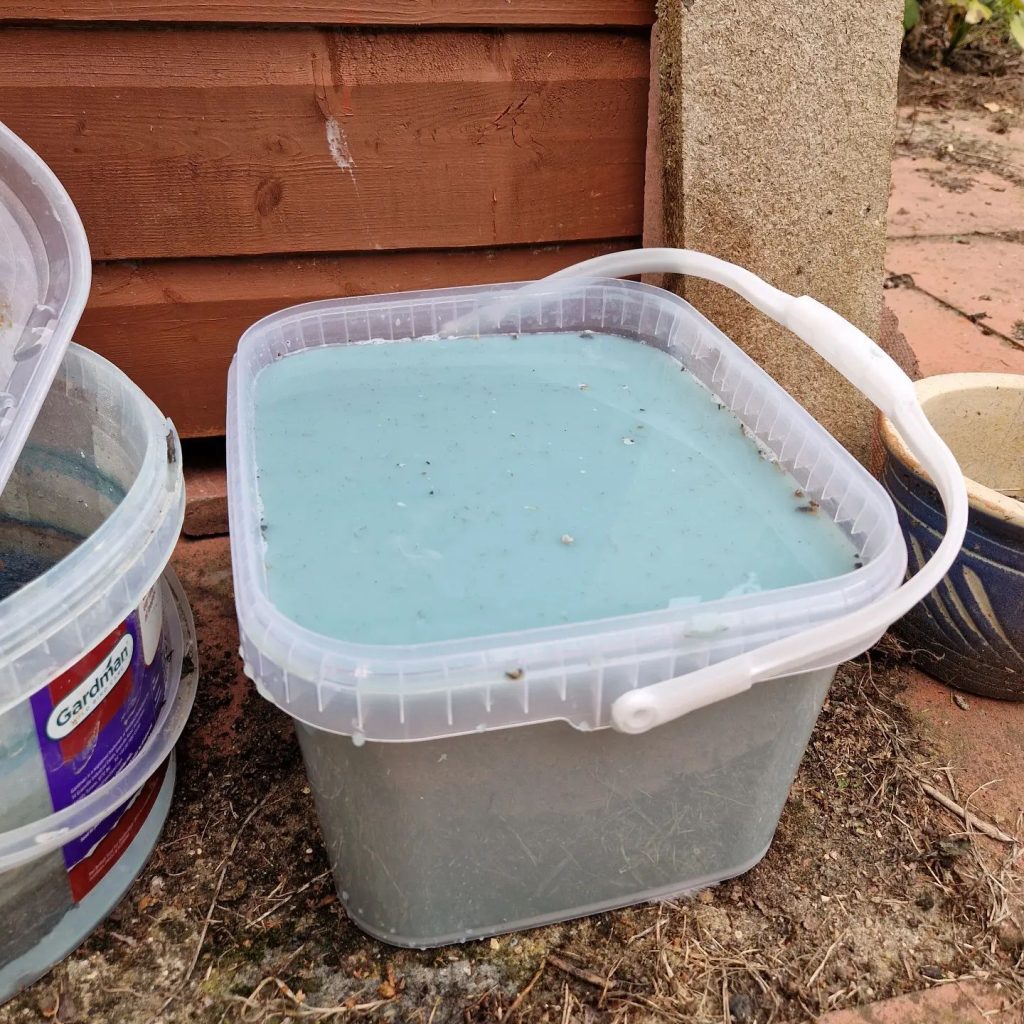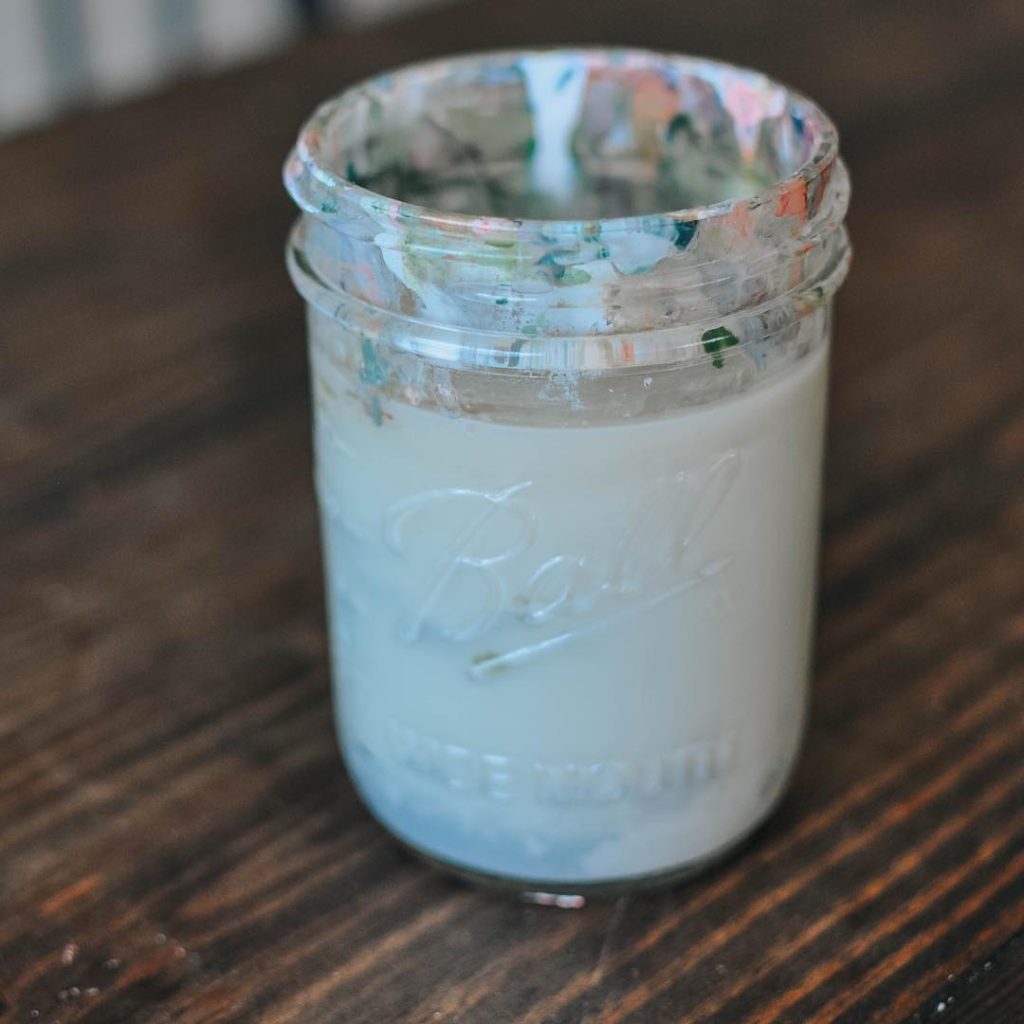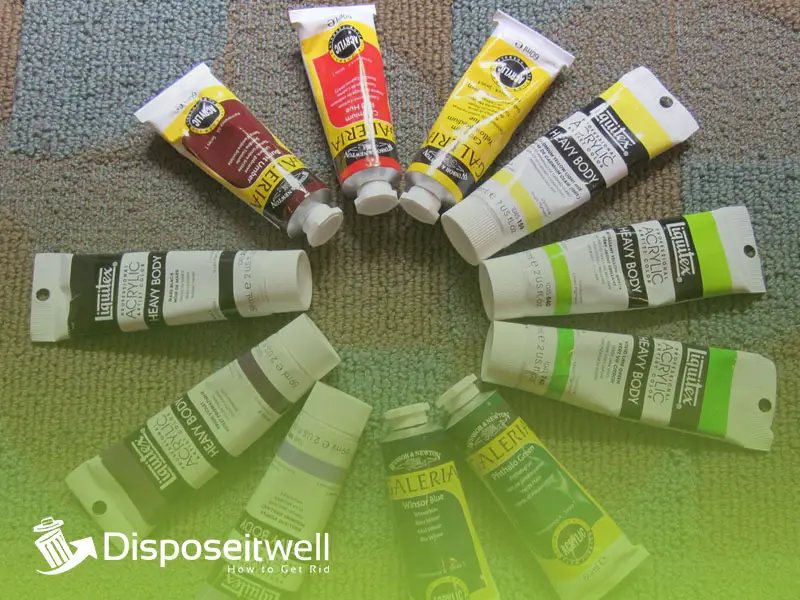Have you ever been painting with acrylic paint and wondered what to do with the leftover paint water? Or maybe you’ve heard the horror stories of paint water overflowing and ruining the floor or worse.
Whether you’re a beginner artist or a professional, the proper disposal of acrylic paint water is essential and it can be a headache for any of us.
Don’t worry! We’re here to help. In this article, we will cover the basics of how to safely and properly dispose of acrylic paint water. We’ll explain what you need to know to make sure you’re doing your part in protecting the environment while keeping your painting supplies clean. Ready to get started?
Is acrylic paint water harmful?
Acrylic paint is water-based and is generally not harmful. However, it is always a good idea to use it in a well-ventilated area and avoid ingesting it. If you do get acrylic paint on your skin, you can wash it off with soap and water. It is also important to keep it away from children and pets.
How to Dispose of Acrylic Paint Water?

When it comes to painting, acrylics are one of the most popular choices. They’re affordable, easy to work with, and the colors are bright and vibrant. The acrylic paint market is almost $120Million with an annual growth of around 4.5% which itself tells about the popularity of this paint. Nevertheless, it’s important to be aware of the environmental impact of disposing of acrylic paint water.
How should acrylic paint water be disposed of? As with all paint, the most important thing to remember is to never dump it into the environment or down the drain. Acrylic paint water contains chemicals that can be harmful to the environment, so it’s important to dispose of it correctly. Here’s how to do it:
1. Hardening the Paint for Disposal:
The best way to dispose of acrylic paint water is to let it harden in the can. Make sure that you don’t pour the liquid acrylic paint down the drain or into the trash. This could create a serious environmental hazard. Instead, you should leave the paint to harden in the can.
Acrylic paint is designed to dry quickly, and as it does, it will harden to a solid. The process can take a few days depending on the size of the can, but it is important to allow it to dry completely before disposing of it.
If you are in a hurry, you can speed up the drying process by mixing pet litter into the paint. The litter will absorb the liquid and make the paint harder and easier to remove.
Once the paint has hardened, simply remove it from the can and place it in your regular trash. It is important to note that even after the paint has hardened, it can still be considered hazardous waste. As such, it is best to place any dried paint in a sealed plastic bag before disposing of it to prevent any spills or leaks.
By following these steps, you can rest assured that your disposal of acrylic paint water will be done in a safe and responsible manner. So the next time you tackle a project that requires paint, make sure to take the time to properly dispose of the liquid waste.
2. Use more clean water to dilute the paint water:
Diluting acrylic paint water with clean water is one of the most effective ways to dispose of it. Diluting the paint water with more clean water will help to reduce the paint particles that are present in the water. This will help to reduce the amount of paint that is released into the environment.
It is important to avoid disposing of acrylic paint water directly into drains, toilets, or other water sources. Instead, the water should be discarded into a container that is designated specifically for paints and other art supplies.
The amount of paint in the acrylic paint water should also be taken into account when disposing of it. If the water contains too much paint, it is not safe to use it for dilution purposes. Instead, the water should be disposed of in a safe and secure manner.
3. Use as a drain screen:
One of the best solutions for disposing of acrylic paint water is to use a drain screen. Drain screens are specifically designed for capturing paint particles and debris before it enters the plumbing system. They are typically made out of perforated stainless steel or plastic mesh and can be placed over the drain of your sink or tub. Consequently, any paint residue, particles, or debris will be trapped in the screen and not enter the plumbing system.
By using a drain screen, you can prevent paint particles and debris from entering the plumbing system. This will not only help you to dispose of acrylic paint water responsibly, but it can also help to prevent any clogs or blockages in your plumbing system.
It is simple, inexpensive, and environmentally friendly to dispose of acrylic paint water properly with a drain screen. Let the water run through the screen while it is placed over the drain of your sink. Any paint particles, debris, or residue will be trapped in the screen, preventing it from entering the plumbing system.
4. Hazardous materials collection:
A great option is to use a hazardous materials collection facility. These facilities are designed to handle hazardous materials safely and effectively. Hazardous materials collection facilities will collect and properly dispose of acrylic paint water.
The hazardous materials will be taken to a landfill or an incinerator, where it will be disposed of properly. This is the safest and most efficient way to dispose of acrylic paint water.
Another option is to use a hazardous waste disposal company. These companies specialize in disposing of hazardous materials, and they will be able to handle your acrylic paint water safely and efficiently.
They will be able to collect the paint water, transport it to the appropriate disposal facility, and properly dispose of it. This is the best option for those who need to dispose of large amounts of acrylic paint water.
5. Dispose of the Water at an Approved Site:
Taking acrylic paint water to an approved site is one of the best ways to dispose of it. An approved site is typically a place that has been designed to handle hazardous materials with the right safety protocols in place. This could be a public facility or a privately run waste disposal facility.
It is important to follow the instructions of the facility when disposing of acrylic paint water. This could include any special requirements for the disposal of the water, such as mixing it with other materials or separating it from other hazardous materials. It is also important to ensure that the approved site is properly equipped to handle the disposal of acrylic paint water.
Once the acrylic paint water has been taken to an approved site, it is important to be aware that the water may still contain some harmful chemicals. For this reason, it is important to follow the instructions of the approved site and to wear protective gear when handling the water.
6. Donating:
Putting acrylic paint water to good use and helping those in need is easy by donating it. Many art supply stores, museums, and other organizations accept donations of acrylic paint water for a variety of uses. In art supply stores, the water can be used to clean brushes and other art materials. Museums may use the water to clean and preserve crafts, and other organizations may use it for a variety of purposes.
It is also possible to benefit the environment by donating acrylic paint water. The water can be used to irrigate plants or to water lawns and gardens. It can also be used to clean up spills and other messes.
When donating acrylic paint water, it is important to make sure that it is properly labeled and stored. It is a good idea to include a note with the donation, explaining what the water is and how it should be used. It is also important to make sure that the water is properly disposed of when it is no longer needed. For donations, you can also see this link.
Why should you not drain out acrylic paint water?
The water used to dilute your acrylic paint is not just water — it is a combination of resin, pigment, and various other components. These components will separate out when the paint water is left for an extended period of time, making it difficult to clean the drain.
Moreover, acrylic paints are water-soluble. This means that if the paint water is drained down the drain, it can become stuck in the pipes. This can eventually lead to clogged pipes and expensive plumbing costs.
For all of these reasons, it’s important to avoid draining out acrylic paint water.
Can you recycle acrylic paint water?
The answer is yes, non-toxic acrylic paint is recyclable.
Most recycling facilities will accept both the paint and the paint water. It’s important to keep in mind that the paint water may need to be separated from the paint before it can be recycled. This is because the paint water may contain other materials that can’t be recycled.
It’s also important to note that not all recycling facilities accept paint and paint water. Before recycling your acrylic paint and paint water, make sure to check with your local recycling center to see what materials they accept. This will ensure that you are disposing of your materials properly and helping to keep our planet clean.
No matter what kind of paint you use, it’s important to recycle it properly. You can recycle non-toxic acrylic paint at a recycling facility. It’s also important to remember that the paint water can be recycled as well. By recycling your paint and paint water, you’re helping to keep our planet clean and healthy. You can check this link for recycling.
What to do with paint bottles?

One of the best ways to get rid of paint bottles is to recycle them.
Recycling paint bottles are an excellent way to reduce your carbon footprint, as it helps to reduce waste in landfills and prevents toxic chemicals from entering the environment. It can also save you money, as recycling paint bottles can earn you credits that can be applied to future purchases.
The process of recycling paint bottles is relatively straightforward. First, make sure that the paint bottles are empty. If there is still some paint left in the bottle, it is best to use it up or dispose of it properly.
Next, remove the lids and labels from the bottles and place them in a recycling bin. If possible, rinse out the bottles with water before adding them to the bin. This will help to reduce the amount of paint residue left in the bottles and make them easier to recycle.
Once the bottles are in the recycling bin, they will be taken to a recycling center and melted down into a new product. This could be anything from a new bottle of paint to a plastic bin or even a new piece of furniture.
FAQs
How to store acrylic paints?
Make sure acrylic paints are stored in an airtight container away from damp or wet areas and in a place where the temperature stays between 60° and 80° F.
Additionally, it is important to keep the lid of the container sealed tightly and to not expose the paints to direct sunlight or extreme temperatures.
Do acrylic paints affect the environment?
No, acrylic paints are not environmentally friendly. They contain heavy metals and volatile organic compounds (VOCs) which can be hazardous to the environment.
The VOCs released during painting can pollute the air and contribute to smog and other environmental issues. In addition, some of these compounds, like xylene, styrene monomer, toluene, and benzene-based solvents, can contaminate water streams and harm aquatic environments.
How to remove acrylic paint?
The best way to remove acrylic paint is to first scrape off as much of the paint as possible with a blunt tool such as a plastic spoon or a credit card. Once you have scraped away as much of the paint as possible, you can use a paint remover or a solvent such as rubbing alcohol, acetone, or lacquer thinner to remove the remaining paint.
Make sure to wear gloves when using any of these solvents and test a small area first to ensure that the solvent won’t damage the material underneath. After the paint has been removed, use warm soapy water and a cloth to wipe away any remaining residue.
Can you wash paint brushes in the sink?
No, you should not wash paintbrushes in the sink. Paint brushes contain potentially harmful chemicals, which can seep into the sink and other parts of the plumbing system.
It’s best to use a dedicated container for cleaning paintbrushes, such as a bucket or a kitchen sink specifically designed for painting. This will help keep the chemicals contained and away from the plumbing.
Conclusion
Properly disposing of paint and paint water is an important part of keeping the environment clean and healthy. Paint can be recycled, while paint bottles should be placed in a recycling bin after lids and labels are removed. The proper disposal methods need to be followed to ensure that hazardous chemicals do not end up in landfills and contaminate the environment.
It’s also important to take care of your paint brushes and clean them properly after each use. Following these simple steps can help keep the environment safe for future generations.

Gemma Alexander has an M.S. in urban horticulture and a backyard filled with native plants. After working in a genetics laboratory and at a landfill, she now writes about the environment and recycling topics.


